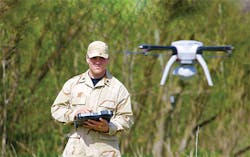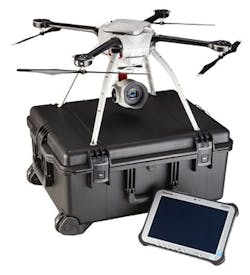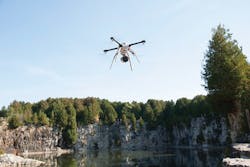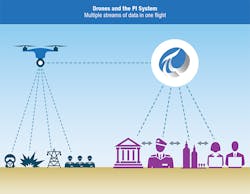Unmanned vehicles are getting smaller and smaller, and so are their sensor payloads, as designers push the limitations on small size, weight, and power consumption for unmanned vehicle sensor payloads.
By J.R. Wilson
A decade and a half of combat in Southwest Asia saw unmanned aerial vehicles (UAVs) grow from an interesting and sometimes useful addition to intelligence, surveillance, and reconnaissance (ISR) in a chaotic battle space to an essential part of U.S. and coalition capabilities. As their value for an increasing number of missions grew, so did research and development of smaller and more capable platforms and sensors.
UAVs that have deployed to the region ranged from the giant Global Hawk to hand-launched Micro UAVs (MUAVs) that are small and light enough to be carried in a single warfighter's backpack. Major advances in miniaturization and reduced power demands saw the variety of sensors and missions increase to where UAVs are not only ubiquitous today, but also essential to the missions of all ground forces.
One area that did not expand rapidly was manpackable UAVs. Stringent size, weight, and power (SWaP) requirements have made it extremely difficult to justify adding new field equipment.
"The soldier can only carry so much weight and only has so much time to think about these things," explains Michael Groenert, deputy director of the science & technology division at the U.S. Army Night Vision & Electronic Sensors Directorate at Fort Belvoir, Va. Today the warfighter's most important job "is to stay alive and deal with the enemy," he says. "If you give them systems that take a lot of time to put together or fly and are twitchy, they won't use them. If a Micro UAV doesn't help the soldier without getting in the way, they won't fly."
In this kind of environment, field tests involving the warfighters are paramount. "Anything that is close to the soldier goes through a lot of iterations before people become comfortable with using it," Groenert continues. "It is an ongoing and continuing conversation with the soldier and these small UAVs must provide something the soldier doesn't have today without increasing the burden, both physical and cognitive. That's something our lab works to support."
The value of manpackable UAVs for individual warfighters or small units is obvious: an immediate, real-time ability not only to see over the next hill and around the next building, but also for communications and to receive sensor data on possible chemical, biological, or radiological threats.
Payload crunch
The difficulty is packing high-level sensors, power for platform and sensors, onboard processing, guidance and navigation, and communications into a package small enough to fit into a backpack with little assembly required. Using such an MUAV ideally should be no more complicated than a hand grenade: pull it out, turn it on, and throw it toward the target.
"Industry and government labs have continued to provide improved capability - in acuity, range, and SWaP - since the proliferation of manpackable unmanned aircraft systems (UAS). The military continues to seek R&D for advanced sensing capabilities on small UAS that often times are only found on larger UAS or even manned aircraft," notes Col. Paul Cravey, director of the Army Training and Doctrine Command's Capability Manager for UAS.
The Army continues to investigate and support research for improved electro-optical sensors; change detection; chemical, biological, radiological, nuclear, and explosives (CBRNE) detection; electronic warfare; network extension; and signals payloads to push advanced sensing capabilities to the lowest tactical echelon possible, Cravey says.
The military relies heavily on commercial developments, while modifying economically to meet combat requirements and put their subsequent use beyond the capabilities of an enemy who also could buy the base technology on the open market. The first commercial sensor capability to be adapted for MUAVs was imaging, which must meet day/night and all-weather requirements.
"On a small UAV, microelectromechanical systems (MEMS) and uncooled technologies enable a true nighttime capability, using a solid-state silicon camera that is lightweight, low-power, and imaging in the long-wave IR band, so you get the same quality imaging day or night in all weather conditions," says Groenert. "We continue to try to mature and improve image intensifier technology. Current tech isn't appropriate for small UAVs, so the lab has invested in improved low-light intensified imaging, which is not as mature as the uncooled microbolometers used in most Micro UAVs today."
The ability to see at night is a non-trivial proposition. "Being able to see at night is a challenging goal. The commercial solution looks easier than it is because they don't have to worry about data security, compromised networks or the bandwidth limitations soldiers face on the battlefield," Groenert says. "The Army is investing a lot in miniaturizing the processing required to handle these high-resolution sensors and improve their autonomy, so you don't have to send the entire raw image down a pipe. But separating the sensor from all that processing is getting harder."
The power challenge
As with virtually every technology developed for the individual warfighter or small unit, power is one of the most daunting challenges. With MUAVs, the trade-off between power and payload forces the warfighter to choose between sensors, ammunition, or water - the sensors lose every time. The same applies to cooling small and sophisticated electronics.
"Thermal management - cooling and ruggedization of semiconductors allowing them to be conduction cooled - is one of the R&D drivers in this arena," says Benjamin Sharfi, CEO of General Micro Systems in Rancho Cucamonga, Calif. "Current solar technology is silicon-based and not bendable, so whatever UAV you create would have a shell that is a solar collector, so you can harvest power from the sun from any angle. That means manufacturing a solar cell that is not flat."
A newly evolving application for manpackable UAVs is weaponization. One such platform has been deployed to Afghanistan; the Switchblade from AeroVironment Inc. in Monrovia, Calif., was built as a concept demonstrator for the Army's Lethal Miniature Aerial Munition System (LMAMS) program, although the Army categorizes it as a "tactical missile system" rather than a UAV.
Originally conceived by the Air Force Special Operations Command, the 5.5-pound (including launcher), GPS-guided Switchblade small UAV is armed with a 40-millimeter grenade-like warhead, has a range as far as six miles, and an endurance of about 15 minutes. That gives it limited loiter capability as its electric propulsion systems enable it to search in near silence for fixed or moving targets beyond line-of-sight or hidden behind walls or other obstructions. By identifying and striking a specific target with a relatively small explosive, it is far less likely to harm civilians or property close by.
"[Switchblade] provides a very, very low collateral damage footprint compared to mortars and other weapons at a squad or platoon's disposal," says William Nichols, Army PEO Missiles and Space Close Combat Weapons Systems Program office. "The operator has the ability to wave off this missile within approximately four seconds of detonation."
Digital data links
In April 2016, AeroVironment announced development of the Block 10C upgrade to Switchblade, incorporating a digital data link (DDL) to provide stable and secure encrypted communications and more efficient use of existing frequency bands while significantly reducing the likelihood of signal interception.
The Block 10C upgrade also enables users to fly several Switchblades at the same time and place without signal conflict. Operational ranges can increase significantly using another DDL-equipped UAV, facilitating the automatic communication of mission plans from one platform to another, also known as sensor-to-shooter operations.
Others contending for a future Lethal Miniature Aerial Munition System program-of-record contract include Textron (Battlehawk), Lockheed Martin (Terminator), and Israel's uVision (Hero). Other nations working on weaponized small UAVs include Poland, with WB Electronics Warmate, and Iran. There also have been reports of miniature "flying IEDs" being used by ISIS against Kurdish fighters in Syria, a development that is likely to grow rapidly as commercial UAVs, already carrying cameras of various sizes and resolution, are modified with explosives or even chemical, biological, or radiological weapons.
Just as the weaponized Predator and Reaper have become the best-known UAVs for their "drone strikes" against enemy targets in Southwest Asia, sensor-packed platforms of all sizes will remain the primary type of aerial robots deployed by the U.S. and other militaries. Manpackable MUAVs increasingly will become capable and in growing demand by infantry and special operations forces. Driving research for such platforms will be the need to fly anytime, anywhere, using tablet computer-based control software for day and night missions, an airframe able to tolerate wind gusts as strong as 90 miles per hour, and all kinds of inclement weather at altitudes to 1000 feet.
Imperative for small payloads
From a payload perspective, there needs to be continued advances in robust, durable, small, power-lean sensors and communications, as well as lightweight long-charge or in-flight rechargeable power systems.
"As operators use UAVs more frequently, they uncover new forms of application, which drives into the sensor and payload technologies," says David Proulx, vice president of product & marketing at UAV specialist Aeryon Labs in Waterloo, Ontario. "All our customers start with relatively simple imaging tasks, then migrate to more complex imaging, then to non-imaging tasks, such as using the UAV as a communications node. So as more people use it, that creates a feedback loop to us to develop new technologies.
"We do see a general trend of driving situational awareness down to the squad, platoon, or even individual operator level," Proulx continues. "We think there is a great trend where situational awareness and ISR become on-demand tools the soldier can deploy from the backpack. That means providing them with easy-to-use UAVs that don't require more than a couple of days training. Putting ISR in the hands of the individual warfighter enables faster and more flexible response. Being self-sufficient in situational awareness and mission plans, allowing the individual operator to make decisions based on that real-time information, enables them to make better decisions based on immediate circumstances."
New requirements
There is no shortage of new requirements coming from end users as a function of increased usage and understanding. Those include real-time system interoperability, where manpackable UAVs operate in concert with ground robots and larger aircraft, getting all that data back in a consistent form to the same user. Another is distributed command and control, shared among several personnel rather than relying on a single individual. Evolving MUAV sensors also are opening a broad range of new possibilities, such detecting specific compounds more safely than a ground unit.
Manpackable MUAVs with advanced sensors and other payloads will significantly change future combat tactics, techniques, and procedures (TTPs), concept of operations (CONOPS), and individual/small unit effectiveness and survivability.
"The goal is to increase soldier situational awareness while decreasing workload and cognitive burden, so increased autonomy, reducing the amount of data the soldier has to handle while improving his awareness and adaptability to evolving conditions on the ground," Groenert says. "There is a big push on the sensor side to not just make higher resolution and frame rate sensors, but sensors that are smarter. There is only so much bandwidth on the battlefield and so much effort the soldier can put into it. The longer it takes for an image to reach the soldier, the less valuable it is. So the closer to the imager that processing occurs, the better," Groenert says.
Tying sensors together is a special challenge. "Making sensors multifunction is another part of that, such as enabling the sensor to provide 3D information," Groenert says. "As they move around the battlefield, you get imagery of the same target from multiple sources, so can you infer structure using that. If the soldier can get 3D understanding of the battlefield from passive sensors, that's another piece of leverage. So increasing sensor capability without increasing the workload to interpret that data has been a big push for us."
There has been growing concern among military and industry leaders that the technology gap that has set the U.S. apart from the rest of the world is closing and the nation ultimately may lose that lead. Groenert says he agrees the defense industry will face a shortage of top-grade engineers in the future - with more PhDs going to foreign students who return home rather than working for U.S. companies and Americans who go to work in the commercial sector, including overseas, rather than in what is seen as a diminishing defense industry. But he also sees that largely as a problem for very specific, military-only technologies.
Market explosion
"The small UAV field is exploding right now, with significant commercial work being done, especially embedded processing," Groenert says. "With targeted investment and guidance, the Army can leverage a lot of that work and make significant advances in areas that already are depending on commercial work. I'm optimistic we can follow the model of leveraging the domestic commercial technology base and not doing everything purely in-house for the military."
With advanced sensors providing increasingly intelligent eyes on the battlefield and embedded processing to reduce the amount of time and effort a soldier must devote to overwatch and situational awareness, MUAVs have the potential to become very important to future tactics and operations.
"The same missions can be done with fewer soldiers or with an enhanced awareness and better response to threats as sensors and processing continue to improve," Groenert continues. "A lot of capability can be added in terms of reduced decision times, enhanced ability to detect and respond to threats and create useful effects with fewer soldiers in harm's way."
Technology trends include automation to reduce the number of UAV operators. "Today a lot of systems require a soldier for every platform, putting a lot of his brainpower into keeping the system flying and interpreting the data coming from it," Groenert says. "In the future, with improved displays and sensor autonomy, moving from imagery to information, the soldier can lift his head up and trust the sensor and aircraft carrying it to tell him when he needs to look at the imagery."
Each new technology that has brought individual warfighters into closer, real-time contact with higher headquarters, such as individual communications gear, has raised the specter of those outside the theater of operations micromanaging those on the inside. Instead, the result has tended more toward a better informed warfighter having greater autonomy to deal with his immediate combat environment.
The future of manpackable MUAVs and sensors is a much broader issue than individual technology developments or even America's ability to maintain a technological edge, says Steven Sarnecki, vice president of U.S. federal & public sector affairs at UAV software specialist OSIsoft LLC in San Leandro, Calif.
Instead, Sarnecki sees manpackable UAV development as ensuring the U.S. military has the right infrastructure - from command headquarters to field units to the platforms themselves - to aggregate an increasingly heavy data load, transforming raw data to useful information made available to those who need it in real time.
Sarnecki sees MUAVs as remote-sensing platforms, deployed where and when needed, with sensor data then integrated in real time with geospatial data. This can create a mobile sensor that can provide any type of measurement back to its user, then integrate that into a map with data that changes in real time. The challenge, he adds, is to break down the tendency to "silo" problems to fit silos of funding.
"What we have to deal with now is theater-scale situational awareness, which requires a broader perspective rather than very prescriptive funding to solve a past problem," Sarnecki says. "There is an opportunity for video R&D to be enhanced and leveraged with miniaturized sensor technology that has been developing in parallel."
Device miniaturization has been the primary enabling technology of MUAVs because it decouples the size of the sensor as a limiter on the payload. Sarnecki cautions that simply increasing the amount of data available may not be the key to vastly improved systems.
"The one thing we cannot ignore is that more data is not the answer," Sarnecki says. "With ISR and situational awareness, more information is the answer. We need to manage the volume of data coming in, just as we are in society at large with the Internet of Things. We will be able to collect a lot more sensor data with UAVs; the real key will be to determine differences over time."
At the same time, asymmetrical threats from adversaries such as ISIS mean what used to be restricted to government funding now can be tackled by three jihadists.
The pace of change
"The genie is out of the bottle," Sarnecki says. "We have not lost our ability to innovate, but we have lost pace in our ability to educate new scientists and implement new technologies. Other nations and entities have gotten better at being adept at exploiting technology, including some we have developed. Any organization or country has to be a learning organization, both educationally and through adaptation."
U.S. UAV designers also may be facing a requirement to adapt new designs to new applications more quickly than they ever have been able to do before. "I see us right now being out-adapted," Sarnecki warns. "We may still be smarter and work harder, but there are others in the world who can shift a lot more quickly than we can right now. We're starting to see folks from other countries not just coming here to be educated and then returning home, we're starting to see new technologies coming out of those countries, such as Brazil."
The future of manpackable UAVs, then, is an amalgam of factors, from leadership in evolving technologies to restricted funding to global competition to potential data overload. But what has marked 21st century combat to date may make MUAVs with advanced, even multifunctional, sensors as vital to U.S. military success in the future as improved body armor and precision-guided munitions.
"The days of large, pitched battles in a somewhat predictable fashion are in many ways well behind us, so the idea the warfighter is becoming somewhat more autonomous, with more frequent but smaller in scale operations, speaks to the need to put flexible, small ISR capability in their hands," Proulx concludes.
"The value of a UAV is only as good as its ability to collect and distribute needed data. That speaks not only to having flexible sensor payloads - meaning users can affix different payloads in the field, without tools, in a matter of seconds - but ensuring the captured data is available to everyone. So they have individual level intel-gathering capability, but what they gather is easily and securely shared with all who need it."




